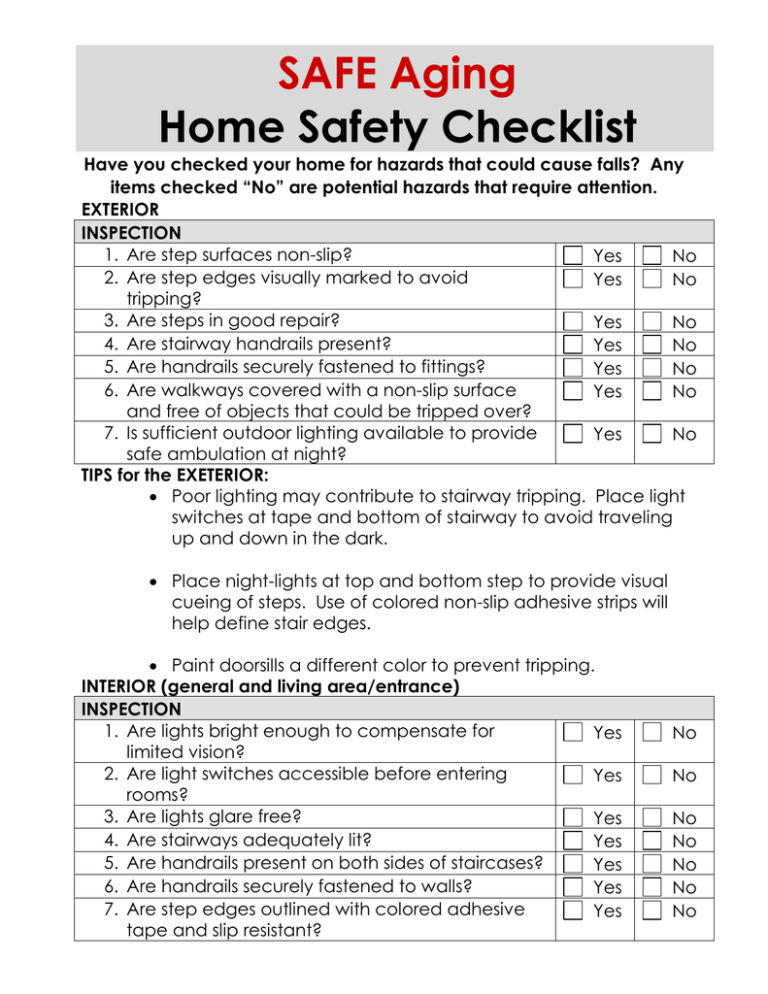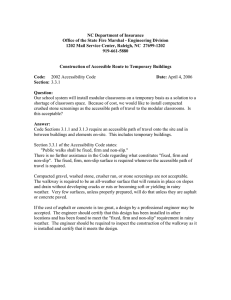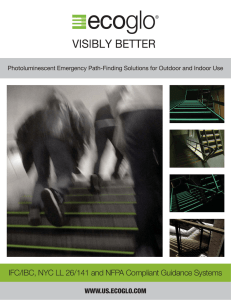Home Safety Checklist for Seniors: Fall Prevention
advertisement

SAFE Aging Home Safety Checklist Have you checked your home for hazards that could cause falls? Any items checked “No” are potential hazards that require attention. EXTERIOR INSPECTION 1. Are step surfaces non-slip? Yes No 2. Are step edges visually marked to avoid Yes No tripping? 3. Are steps in good repair? Yes No 4. Are stairway handrails present? Yes No 5. Are handrails securely fastened to fittings? Yes No 6. Are walkways covered with a non-slip surface Yes No and free of objects that could be tripped over? 7. Is sufficient outdoor lighting available to provide Yes No safe ambulation at night? TIPS for the EXETERIOR: Poor lighting may contribute to stairway tripping. Place light switches at tape and bottom of stairway to avoid traveling up and down in the dark. Place night-lights at top and bottom step to provide visual cueing of steps. Use of colored non-slip adhesive strips will help define stair edges. Paint doorsills a different color to prevent tripping. INTERIOR (general and living area/entrance) INSPECTION 1. Are lights bright enough to compensate for Yes limited vision? 2. Are light switches accessible before entering Yes rooms? 3. Are lights glare free? Yes 4. Are stairways adequately lit? Yes 5. Are handrails present on both sides of staircases? Yes 6. Are handrails securely fastened to walls? Yes 7. Are step edges outlined with colored adhesive Yes tape and slip resistant? No No No No No No No 8. Are throw rugs secured with non-slip backing? Yes 9. Are carpet edges taped or tacked down? Yes 10. Are rooms uncluttered to permit unobstructed Yes mobility? 11. Are chairs throughout home strong enough to Yes provide support during transfers? 12. Are telephones accessible? Yes 13. Are electrical and telephone cords taped Yes down securely? TIPS for the INTERIOR (general and living area/entrance): Improve the lighting in your home. Use brighter light bulbs (at least 60 watts). Use lampshades or frosted bulbs to reduce glare. No No No No No No Thick pile carpets may lead to tripping. Carpets of uncut, low pile are preferable. Use polarized window glass or application of tinted material to windows to eliminate glare without reducing light. Reduce floor glare by repositioning light sources. Chair height should be at least 14-16 inches (from seat edge to floor) with armrests to provide leverage during sitting/rising for safer transfers. KITCHEN INSPECTION 1. Are step stools strong enough to provide Yes No support? Are stool treads in good repair and slip resistant? 2. Are commonly used items within easy reach? Yes No Are storage areas easily reached without having to stand on tiptoe or a chair? 3. Are chairs wheel free, armrest equipped, and of Yes No proper height to allow for safe transfers? 4. Are tables secure enough to provide support if Yes No leaned on? 5. Are low-lying objects (coffee tables, step stools, Yes No etc.) that present a tripping hazard out of the way? 6. Are linoleum floors non-slip? Yes No 7. Is there a non-slip mat in the sink area to soak up Yes No spilled water? 8. If the pilot light goes out on the gas stove, is the Yes No gas odor strong enough to alert the individual? TIPS for the KITCHEN: On linoleum floors use slip-resistant floor wax with minimal buffing; use nonskid floor mat by kitchen sink to guard against wet floor. A well-organized kitchen area will make cooking and cleaning easier and prevent falls. Rearrange frequently used kitchen and closet items to avoid excessive reaching /bending. Use a hand-held reaching tools for hard-to-reach objects. BATHROOM INSPECTION 1. Are doors wide enough to provide unobstructed Yes No entering with or without a device? 2. Are door thresholds safe so that they don’t Yes No present tripping hazards? 3. Are floors slippery, especially when wet? Yes No 4. Are skid-proof strips or mats in place in the tub or Yes No shower 5. Are tub and toilet grab bars available? Yes No 6. Are grab bars securely fastened to the walls? Yes No 7. Is toilet seat height elevated at least 24” for easy Yes No transfers? 8. Is there sufficient, accessible, and glare-free light Yes No available? TIPS for the BATHROOM: If you are on strong medication or in a frail condition, do not take a bath or shower by yourself Do no use towel racks for support. Check water temperature by hand before entering bathtub or shower. BEDROOM INSPECTION 1. Is adequate and accessible lighting available? Yes No 2. Are night-lights and/or bedside lamps available Yes No for nighttime bathroom trips? 3. Is the pathway from the bed to the bathroom Yes No clear to provide unobstructed mobility (especially at night)? 4. Are beds of appropriate height to allow for safe Yes No on and off transfers? 5. Are floors covered with a non-slip surface and Yes No free of objects that could be tripped over? 6. Can individual reach objects from closet shelves Yes No without standing on tiptoes or chair? 7. Is there a telephone with reach from the bed? Yes No TIPS for the BEDROOM: Stand up slowly when rising from bed. Wait until your circulation adjusts to an upright position. Do not wear loose clothing that can get hooked on doorways or furniture as you walk. Pathway from the bed to bathroom should be unobstructed. Avoid stacking newspapers, books, and magazines on floor. Bed height of approximately 18 inches (from top of mattress to floor) allows for safe to transfer Bed mattress edge should be firm enough to support a seated person without sagging. Other Things You Can Do to Prevent Falls Exercise regularly. Exercise makes you stronger and improves your balance and coordination. Have your doctor or pharmacist look at all the medicines you take, even over-the-counter medicines. Some medicines can make you sleepy or dizzy. Have your vision checked at least once a year by an eye doctor. Poor vision can increase your risk of falling. Get up slowly after you sit or lie down. Wear sturdy shoes with thin, non-slip soles. Avoid slippers and running shoes with thick soles. For more information about fall prevention please call Ashley at 559.278.7539 or visit www.safecvc.org A Consortium with California State University, Fresno





